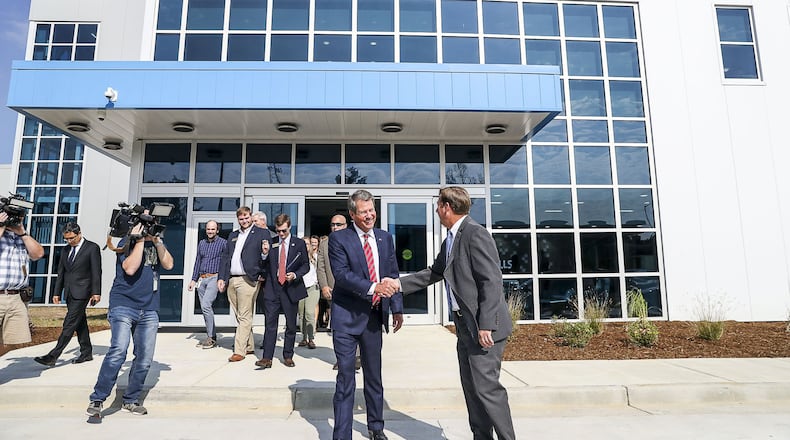Many in Georgia’s solar industry criticized U.S. tariffs slapped on imported solar energy systems. But a sprawling new North Georgia assembly plant with 650 jobs was built partly as the result of the levies, the facility’s owner says.
The Hanwha Q Cells assembly plant now operates around the clock in Dalton and is billed as the largest in the Western Hemisphere. On Friday, Gov. Brian Kemp and a Trump Administration trade official were at the plant to celebrate its grand opening.
The South Korea-based company had long wanted to assemble solar panels in the United States, its largest market, said Scott Moskowitz, who is director of strategy and market intelligence for the Q Cells operation.
Tariffs put in place by the Trump Administration last year “played a big part” in the decision to finally do it, Moskowitz told The Atlanta Journal-Constitution. By building in the U.S., the company could avoid the levies.
The plant began operations earlier this year, and most of the jobs already have been filled.
U.S. solar advocates praise the addition. But they also say Georgia and the nation have lost far more than they’ve gained from the federal government smacking import taxes on a young and booming energy sector.
“The industry would have grown faster, and we would have created more jobs” without the tariffs, said James Marlow, who co-founded Atlanta-based Radiance Solar, which installs solar systems, including one in the parking lot of the new Hanwha plant.
Still, the industry has a rich pipeline of new solar installations expected nationally, particularly in the Southeast. Solar panels are no longer rare in Georgia. And state officials plan to rely on solar even more in the future.
The Hanwha facility, three times the size of an average Walmart, is designed to churn out 12,000 solar panels a day. In a year’s time, that would be enough to produce about as much electricity as the Hoover Dam at its peak.
Kemp joined other dignitaries on Friday at a grand opening celebration for the facility, which is in line to get $37 million in state and local incentives tied to job creation and investments. He didn’t bring up ongoing trade battles in his prepared remarks.
The Dalton plant assembles components made elsewhere, often overseas.
Crucial solar cells, for example, come from South Korea. Previously, most of Hanwha’s assembled panels destined for the U.S. were built at its facilities there and in Malaysia. But they were subject to a new round of U.S. tariffs that went into place in early 2018.
Hanwha said it is seeking exclusions from tariffs on imported components it uses in U.S.-assembled panels. And longer term, it hopes to spur suppliers to provide more U.S.-built components. Meanwhile, Moskowitz said the company built a particularly large plant to gain economies of scale and keep costs down even after tariffs are phased out.
The tariff situation is complicated, Moskowitz said. “It’s a story of navigation … of folks trying to figure out what is the best way for this industry to proceed.”
The U.S. solar tariffs stem partly from a protest brought by a Georgia-born solar equipment maker.
Suniva, a Norcross-based company launched by a Georgia Tech engineering professor, was a darling of the local solar industry. But it fell on hard times competing with overseas rivals.
It ended up with new ownership tied to a Hong Kong billionaire. After years of losses, Suniva filed for bankruptcy protection in 2017. It soon filed a case with the International Trade Commission claiming it was undercut by Chinese-related manufacturers illegally dumping cheap panels on the U.S. market. The ITC agreed with Suniva. The Trump Administration eventually set a 30% tariff across many nations, with gradual decreases over several years.
The case made Suniva an enemy of many in the U.S. solar industry, where jobs are overwhelmingly tied to installation firms rather than U.S. manufacturers.
The Solar Energy Industries Association warned that, depending on how steep they were, the levies could derail demand by up to two-thirds, double the price of solar and eliminate the jobs of 88,000 Americans.
The toll hasn’t reached those levels, industry players say.
But, during months of uncertainty about how steep the tariffs would be, prices of solar panels jumped up, temporarily reversing years of price declines. Projects were put on hold or canceled.
SEIA estimates that more than 9,000 U.S. solar jobs were either lost or not added due to the tariffs. It expects the levies will have curtailed $8 billion in solar investments by 2022.
The industry is resilient, but it “would undoubtedly look better today without the tariffs,” SEIA general counsel John Smirnow wrote to the AJC.
A variety of local players took a hit. An Atlanta-based installer, Hannah Solar, filed for bankruptcy court protection earlier this year so it could reorganize its finances.
Part of the problem was a sharp slowdown in business tied to the tariffs, said co-founder Pete Marte. Also, he said, he didn’t cut overhead quickly enough as the tariffs loomed.
The company, which worked on high-profile Atlanta projects at the Mercedes-Benz Stadium and NCR’s headquarters, had 120 employees. It’s down to 30 now.
The U.S. solar industry employed about 242,000 people last year, a second straight year of declines after years of growth since 2010, according to the Solar Foundation. Last year alone, Georgia lost nearly as many solar jobs as the new Hanwha plant is creating.
Solar manufacturing also has seen declines since the tariffs were announced, it found. But the foundation is predicting manufacturing jobs will rise this year, encouraged in part by tariffs.
That involves more than just Hanwha.
Other manufacturers, including some from overseas, are building or expanding several U.S. plants. China’s JinkoSolar, for example, has added an assembly facility in Jacksonville, Fla., that’s slated to have about 200 jobs. LG Electronics of South Korea is expected to create 160 jobs at another in Huntsville, Ala.
Solar prices have been declining again, making systems more attractive for consumers.
But early on, tariff pressures added $1,000 or more to typical residential solar projects, said Vikram Aggarwal, the chief executive of Boston-based EnergySage, a platform that helps consumers get competing quotes from solar contractors. Now that the tariffs are gradually being stepped down, the price difference is diminishing, he said.
About the Author
The Latest
Featured






